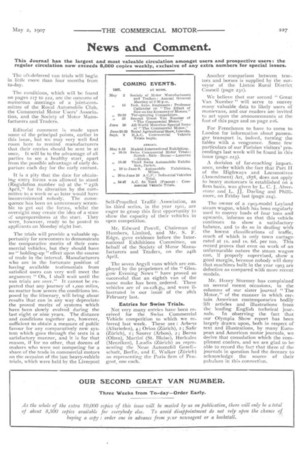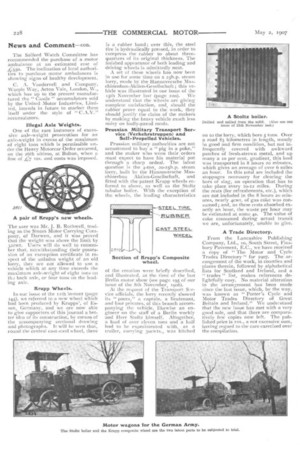News and Comment.
Page 15

Page 16

If you've noticed an error in this article please click here to report it so we can fix it.
This Journal has the largest and most valuable circulation amongst users and prospective users: the regular circulation now exceeds 8,0130 copies weekly, exclusive of any extra numbers for special issues.
The oft-deferred van trials will begin in little more than four months from to-day.
The conditions, which will be found Oil pages 217 to 222, are the outcome of numerous meetings of a joint-committee of the Royal Automobile Club, the Commercial Motor 'Users Association, and the Society of Motor Manufacturers and Traders.
Editorial comment is made upon some of the principal points, earlier in this issue, but we may very well find room here to remind manufacturers that their entries should be sent in at once. It will be to the advantage of all parties to see a healthy start, apart from the possible advantage of early departure each day for the early entrant.
It is a pity that the date for obtaining entry forms was allowed to stand (Regulation number to) at the "25th April," for its alteration by the committee to a week or so later would have inconvenienced nobody. The conse. quence has been an unnecessary scramble to get out the forms, whilst the oversight may create the idea of a state of unpreparedness at the start. They were, however, ready to be posted to applicants on Monday night last.
The trials will provide a valuable opportunity for newcomers to demonstrate the comparative merits of their commercial vehicles, but they should have no" holding-up " effect upon the course of trade in the interval. Manufacturers who are in the fortunate position of having available testimonials from satisfied users can very well . meet the argument " Oh, I shall wait until the van trials are over." It cannot be expected that any journey of ',coo miles, no matter how severe the conditions imposed by the itinerary, will bring about results that can in any way depreciate the proved merits of systems which have been slowly evolved during the last eight or nine years. The distance and conditions together are, however, sufficient to. obtain a measure of public favour for any comparatively new system which goes through the tests in a satisfactory manner, and it is for that reason, if for no other, that dozens of makers who were not competing for a share of the trade in commercial motors on the occasion of the last heavy-vehicle trials, which were held by the Liverpool Self-Propelled TraffieAssociation, as its third series, in the year 19oi, are eager to grasp this first opportunity to show the capacity of their vehicles in open competition.
Mr. Edward Powell, Chairman of Humbers, Limited, and Mr. S. F. Edge, gave evidence before the International Exhibitions Committee, on behalf of the Society of Motor Manufacturers and Traders, on the 24th April.
The seven Argyll vans which are employed by the proprietors of the Was.gow Evening News" have proved so successful that an eig.hth van of the same make has been ordered: These .vehicles are of io-i2h.p.,, and were illustrated in our isstie of the 28th February last.
Entries for Swiss Trials.
Not very many entries have been received for the Swiss Commercial Vehicle competition to which we referred last week. These are : Arbenz (Alisrieden), 4; Orion (Zurich), 2 ; Safi.r (Zurich), 2 ; Saurer (Arbon), 2 ; Berna (Olten), Martini (St. Blaise), Herkules (Menziken), Laudis (Zurich) as representing the Neue Automobil Gesellschaft, Berlin, and E. Walker (Zurich) as representing the Paris firm of Peugeot, one each. Another comparison between tractors and horses is supplied by the surveyor of the Linton Rural District Council (page 231).
We believe that our second " Great Van Number " will serve to convey many valuable data to likely users of motorvans, and our readers are invited to act upon the announcements at the foot of this page and on page 216.
For Frenchmen to have to come to London for information about passenger transport is, indeed,, turning the tables with a vengeance. Some few. particulars of our Parisian visitors' pro. ceedings last week will be found in this issue (page 223).
A decision of far-reaching importance, under which the fact that Part II of the Highways and Locomotives (Amendment) Act, 1878, does not apply to heavy motorcars is established on a firm basis, was given by L.• C. J. Alverstone and L. JJ. Darling and Phil& more, on Friday last (page 224).
The owner of a 1903-model Leyland ,steam wagon, which has been regularly used to convey loads of four tons anti upwards, informs us that this vehicle continues to show a satisfactory balance, and to do so in dealing with the lowest classifications of traffic, much of which is only town cartage rated at is. and is. 6dt per ton. This record proves that even on work of an unfavourable nature the steam wagorr can, if properly supervised, show a good margin, because nobody will deny' that machines built in the year 1903 are defective as compared with more recent models.
Mr. Henry Sturmey has complained on several recent occasions, in the columns of . our sister journal " The Motor," of the manner in which certain American contemporaries bodily 'lift • articles and illustrations front the. leading English technical journals. In observing the fact that our Olympia Show report has been largely drawn upon, both in respect of text and illustrations, by many European and American motor journals, we derive that consolation which the compliment confers, and we are glad to be able to record the fact that three of the journals in question had the decency to acknowledge the source of their pabulum in this connection.
The Salford Watch Committee has recommended the purchase of a motor ambulance at an estimated cost of ,55o. The inclination of local authorities to purchase motor ambulances is showing signs of healthy development.
C. A. Vandervell and Company, Warple Way, Acton Vale, London, W., which has up to the present •manufactured the " Castle " accumulators sold by the United Motor Industries, Limited, intends in future to market them itself under the style of " C.A.V." accumulators.
Illegal Axle Weights.
One of the rare instances of excessive axle-weight prosecution for an axle-weight in excess of the maximum of eight tons which is permissible under the Heavy Motorcar Order occurred, on the 26th ultimo, at Bolton, when a fine of rot, and costs was imposed.
The user was Mr. J. B. Rothwell, trading as the Steam Motor Carrying Company, of Darwen, and it was proved that the weight -was above the limit by 32cwt. Users will do well to remember that, notwithstanding their possession of an exemption certificate in respect of the unladen weight of an old lorry, they are not allowed to use a vehicle which at any time exceeds the maximum axle-weight of eight tons on tIL._ back axle, or four tons on the leading axle.
Krupp Wheels.
In our issue of the 11th instant (page 145), we referred to a new wheel which had been produced by Krupps', of Essen, Germany, and we are now able to give supporters of this journal a better idea of its construction, by means of the accompanying sectional drawing and photographs. It will be seen that, round the central cast-steel wheel, there is a rubber band; over this, the steel tire is hydraulically pressed, in order to compress the rubber to about threequarters of its original thickness. The finished appearance of both leading and driving wheels is admittedly neat.
A set of these wheels has now been in use for some time on a 25h.p. steam lorry, made by the Hannoversch.e Maschinenban-Aktien-Gesellschaft ; this vehicle was illustrated in our issue of the esth November last (page 220). We understand that the wheels are giving complete satisfaction, and, should the rubber prove equal to the work, they should justify the claim of the makers by making the heavy vehicle much less noisy on badly-payed roads.
Prussian Military Transport Service (Verkehrstruppen) and Self• Propelled Vehicles. Prussian military authorities are not accustomed to buy a " pig in a poke," and the maker who woos their orders must expect to have his material put through a sharp ordeal. The latest question is the 4-ton, 2o-25h.p. steam lorry, built by the Hannoversche Maschinerbau Aktien-Cesellschaft, and fitted with the patent Krupp wheels referred to above, as well as the Stoltz tubular boiler. With the exception of the wheels, the leading characteristics of the creation were briefly described, and illustrated, at the time of the last Berlin motor show (see page 195 of our issue of the 8th November, 1906). At the request of the Transport Srvice officials, the lorry recently showed its " paces," a captain, a lieutenant, and (our privates, of this branch accompanying the vehicle, likewise an engineer on the staff of a Berlin weekly and Herr Stoltz himself. Altogether, a load of over eleven tons and a half had to be experimented with, • as a trailer, carrying 3ocwts., was hitched
on to the lorry, which bore 5 tons. Over a road 83 kilometres in length, mostly in good and firm condition, but not infrequently covered with awkward patches of fresh-strewn metal, and up many a to per cent. gradient, this load was transported in 8 hours zo minutes, which gives an average of over 6 miles an hour. In this total are included the stoppages necessary for clearing the bars of slag, an operation that has to take place every 10-12 miles. During the rests (for refreshments, etc.), which are not included in the 8 hours zo minutes, nearly 4cwt. of gas coke was consumed; and, as these rests absorbed exactly an hour, the waste per hour may be estimated at some 45. The value of coke consumed during actual transit we are, unfortunately, unable to give.
A Trade Directory.
From the Lancashire Publishing Company, Ltd., to, South Street, Finsbury Pavement, E.C., we have received a copy of " The Motor and Cycle Trades Directory " for 1907. The arrangement of the work, in counties and places therein, followed by alphabetical lists for Scotland and Ireland,. and a " trades " list, makes references delightfully easy. No material alteration in the arrangement has been made since the last issue, which, by the way, was known as " Porter's Cycle and Motor Trades Directory of Great Britain and Ireland." We understand that the new issue has met with a very good sale, and that there are comparatively few copies now left. The published price is 2 is., a not excessive sum, having regard to the care exercised over the compilation.


























